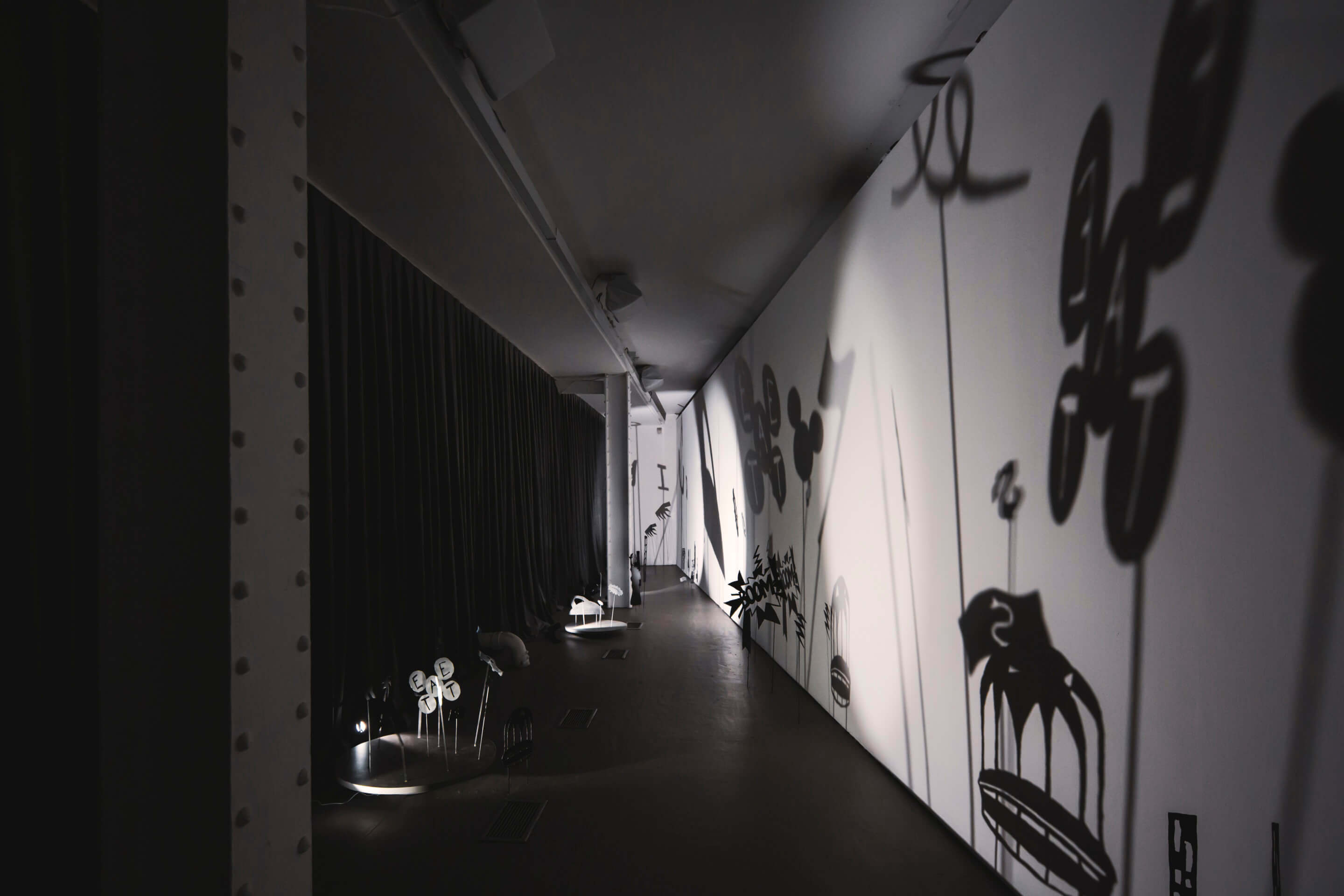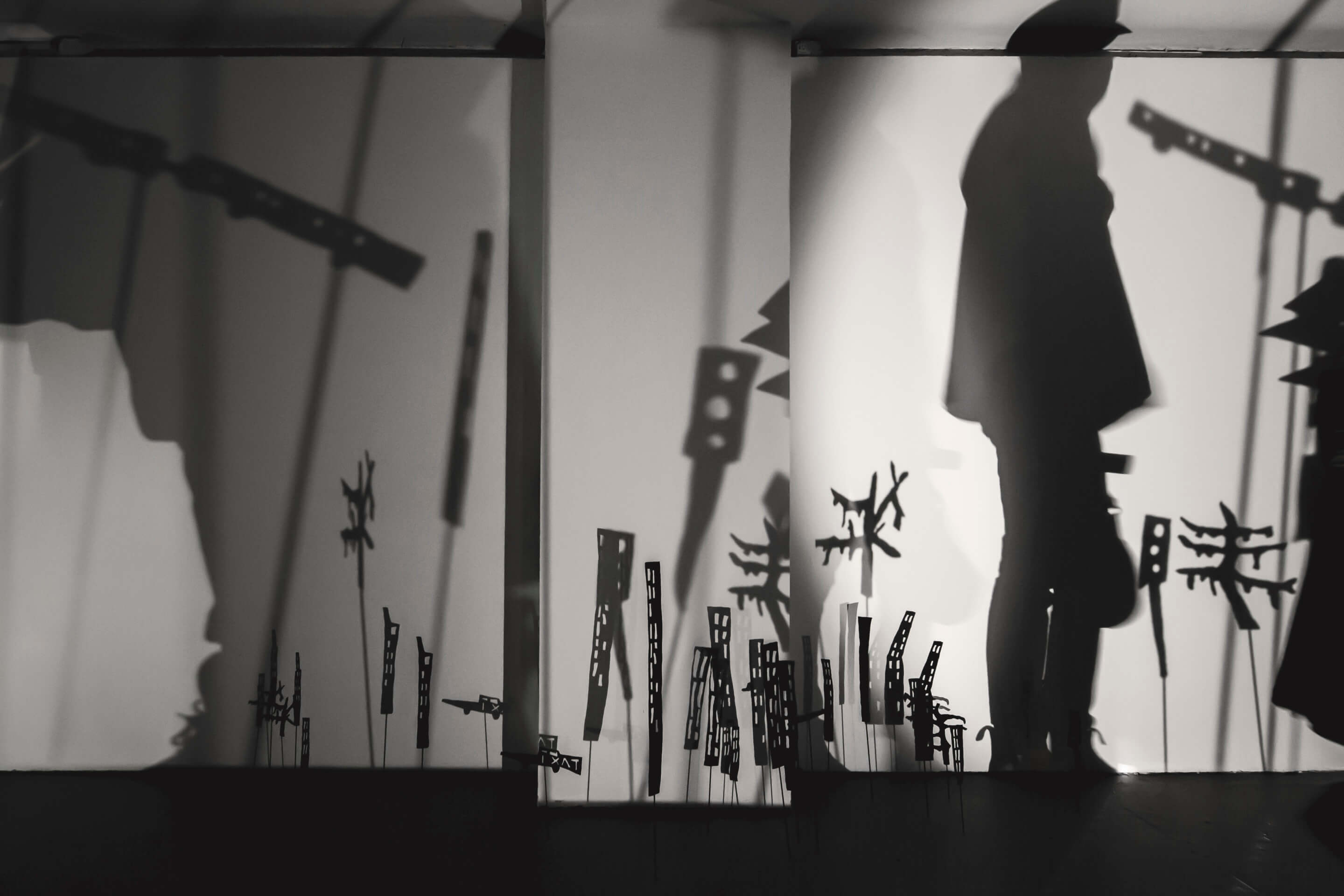Visit SoHo’s Storefront for Art and Architecture this winter and you’ll tumble into a dark carnival where buildings morph, becoming elongated and spindly along the walls, and a haunting soundtrack resounds through the narrow gallery. The latest entry in Storefront’s Building Cycles series, The Great Ruins of Saturn takes the 1964 World’s Fair New York State Pavilion as its central character. Perhaps referencing the pavilion’s observation towers, artist Alvaro Urbano has erected small rotating platforms that support 2D maquettes, backlit to project moving shadows. A short animated video featuring similar penumbral figures plays in a curtained-off space to the right.
Urbano has explored the theme of temporary architecture’s enduring remains before. His 2020 work El Despertar [The Awakening], an “exhibition in one scene” curated by Storefront director José Esparza Chong Cuy and staged at La Casa Encendida in Madrid, reanimated a Modernist pavilion designed for the 1958 World’s Fair in Brussels later relocated to the Spanish capital, where it languishes today. As a New York sequel of sorts (the Queens pavilion, designed by Philip Johnson, also contains the Tent of Tomorrow and Theaterama), The Great Ruins of Saturn is mesmerizing, hypnotic, and visually tight.
But during my visit, it felt superficial. I couldn’t tell if at its core The Great Ruins of Saturn is in on its own dark irony—that it is (literally) flattened entertainment seems to undermine its presentation of architecture as yet another cultural field of distraction and divertissement. And I was a bit confused as to how different elements are meant to cohere. In the accompanying film, a puppet Tent of Tomorrow comes to life and, like a lone dinosaur, sets off across a gray landscape populated with skeletal black structures. The sequence is more reminiscent of a hero’s journey than, say, Godzilla, yet it’s scored to anticipatory, frightening music, resulting in a curious misalignment of image and sound.

Mickey Mouse–like ears appear early in the animation and there are any number of connections one might draw from these. The most obvious, of course, would be Walt Disney and the now-ubiquitous rodent he debuted nearly a century ago. Disney played no minor role in the ’64 World’s Fair; the company used the event as a testing ground for its animatronic technology, including the famed It’s a Small World attraction, which might link back to the mechanized shadow figures populating Storefront’s main space. The exhibition’s press release quotes a lyric from the Disney-commissioned song “Carnival of Progress”—“There’s a great, big, beautiful tomorrow and it’s just a dream away!”—presumably to frame Urbano’s World’s Fair as the flipside of this antiquated cheer.
Ours is a world swallowed whole by capitalist artifice, in no small part resulting from hubristic and bigoted men like Johnson and Robert Moses, who presided over the ’64 fair. But to me, such possible connections felt under-realized. When the only ground of the shadow theater is the blank wall itself, is it a surprise that the viewer is left only with vague impressions? The Storefront gallery is no Plato’s cave, where shadows form what an observer might take to be a reality (e.g., the metaverse, “fake news,” “living in a simulation,” targeted advertising, etc.); rather, Urbano knowingly offers delayed, secondhand images. Maybe this is the point: artifice is reality; marketing is a kind of truth; behind the shadow, more shadows. Or maybe it’s just another gimmick.
Whether intentional or not, The Great Ruins of Saturn chips away at architecture’s self-presentation, displacing its presumptions of solidity with trite mirages, zombie spectacles, paper relics. The circular platforms of the shadow puppetry could be seen as a reference to the expo’s Theaterama, a 44-foot-tall concrete cylindrical cinema whose exterior was once covered in artwork. In the video, teasing moments—puppeteer’s hands which disappear from view as the landscape takes over what began as a stage, for example—hinted at the manipulated theatricality of such master-planned pageants as the Queens fairgrounds. In this way, the sculptural installation reminded me a bit of Alexander Calder’s 1931 miniature circus, a counterpoint to his famous abstract mobiles (perhaps more literally reminiscent of Urbano’s spinning metal works), and the subject of a film where the artist gives voice and motion to his various toys.

Indeed, Urbano’s monochrome carnival shares more in common with cartoons and other mass media than a typical models-and-sketches architecture exhibition. Johnson himself acknowledged the spectacular dimension of the pavilion, describing it as “the Eiffel Tower of Queens.” Entertainment-architecture has only ratcheted up in the half-century since, perhaps peaking with Vessel, Thomas Heatherwick’s macabre modern ruin at Hudson Yards, which the designer suggested might symbolically supersede the Statue of Liberty.
“Disneyfication” routinely appends written descriptions of the sorry state contemporary New York architecture finds itself in. As a shorthand for sanitizing urban life into an idealized and lifeless image of itself, I suppose the term’s fine, though I like fun and fakes and I’ve never quite gotten how artifice and theatricality are inherently bad qualities. While we have Disneyfication in the streets, we have biennialification in discourse, which propagates proofs-of-concept at a rapid clip that, at best, may result in a temporary installation. Whether enduring built spectacle or ephemeral display, in the end architecture is reduced to the urban figures of Urbano’s installation: flat images, shadows of the real.











